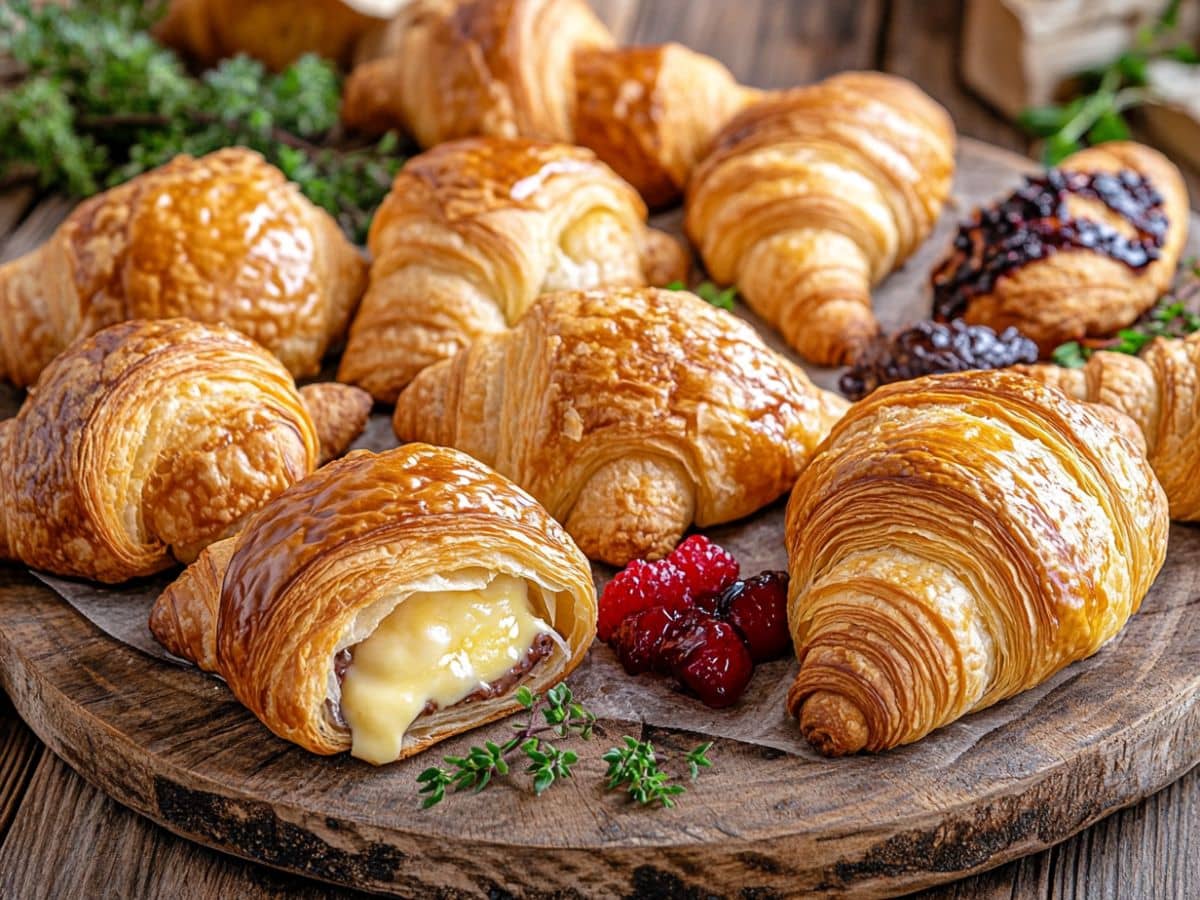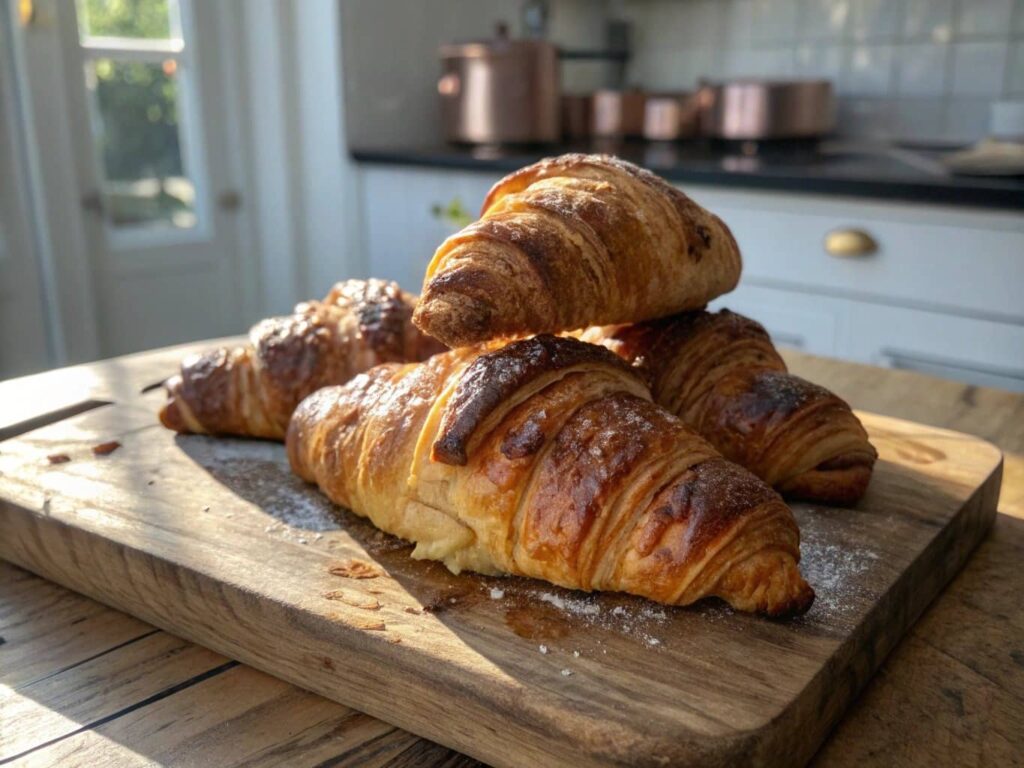Croissants are magical pastries, don’t you think? They’re golden, flaky, buttery, and just melt in your mouth. But have you ever stopped to wonder, “What makes a croissant so special?” These iconic treats, loved worldwide, owe their charm to a perfect balance of texture, flavor, and craftsmanship. The secret lies in the ingredients in a croissant, which come together to create their delicate layers and irresistible aroma. Croissants are a testament to the art of baking. Let’s dive into the fascinating world of croissants and uncover the secrets behind their deliciousness. 🍞
Table of Contents
Croissant Recipe and Its Appeal
Croissants are more than just pastries—they’re little works of art! Imagine pulling apart the golden, flaky layers, each one more buttery than the last. Isn’t it amazing how something so delicate can be so satisfying? Whether you’re enjoying one as a quick breakfast or a luxurious treat with coffee, croissants have a way of making any moment feel special. 🥐
So, what makes croissants so irresistible? The answer lies in their unique combination of ingredients and the magic of how they’re put together. Unlike other baked goods, croissants require a blend of precision, patience, and passion. But don’t worry—it’s not rocket science! Once you understand the basics, you’ll appreciate every bite even more.
Stay with me as we take a deep dive into the ingredients in a croissant that give these pastries their signature taste and texture. From the flour that forms the base to the butter that creates those luscious layers, each component plays a crucial role. Ready to uncover the secrets? Let’s go! 🚀
A Brief History of the Croissant
The Origin Story: From Austria to France
Did you know the croissant didn’t actually start in France? Surprise! Its roots trace back to Austria. The kipferl, a crescent-shaped bread, was the croissant’s early ancestor. It wasn’t until the 19th century that the French took this concept, added buttery layers, and made it the iconic pastry we love today.
How the Croissant Became a Global Icon
Fast forward to today, and croissants are everywhere. Cafes, bakeries, even grocery stores sell them. They’ve evolved too, with creative fillings like chocolate, almond, and ham and cheese. No matter where you are in the world, a croissant feels like a little taste of France.
The Basics: What Makes The Ingredients in a Croissant Special?
The Role of Ingredients in Achieving Flakiness
Croissants are famous for their layers—dozens of them! These layers are created by folding butter into dough over and over. The ingredients in a croissant, particularly the butter, melt during baking, creating pockets of air that make the pastry light, flaky, and irresistibly tender.
Why Proper Lamination Matters in Croissant Making
Here’s a fun fact: the process of folding butter into dough is called “lamination.” If it’s not done correctly, you won’t get those beautiful layers. Think of it like stacking thin sheets of paper. If they’re uneven, the stack falls apart. The same idea applies to croissant dough.
The Key Traditional Ingredients in a Croissant
Now, let’s break down the magic formula. Every croissant has a few essential ingredients in a croissant that work together to create perfection.
Flour: The Foundation of Every Croissant
Flour is like the backbone of the ingredients in a croissant. Most bakers use all-purpose or bread flour because it has enough protein to create a strong dough. This strength is crucial for holding all those buttery layers and giving the croissant its structure.
Butter: The Heart of the Flakiness
Butter is the star of the show. It’s one of the ingredients in a croissant that make it taste so rich and delicious. Good-quality butter (with high fat content) is essential because it creates those gorgeous, flaky layers.
Yeast: Bringing the Croissant to Life
Yeast is the little powerhouse that makes the dough rise. It’s like the croissant’s breathing mechanism, creating tiny bubbles of air that make the pastry light and airy.
Sugar: A Touch of Sweetness
Sugar is one of the ingredients in a croissant that add a subtle sweetness to the dough. It’s not overpowering, but just enough to balance out the richness of the butter.
Milk: Adding Richness to the Dough
Milk makes the dough tender and flavorful. It’s like adding cream to your coffee—it takes the experience to another level.
Salt: Balancing the Flavors
Finally, there’s salt. It might seem simple, but it’s a game-changer. Without it, croissant would taste bland. Salt enhances all the other ingredients flavors, making each bite irresistible.
“Butter is the soul of a croissant. Without it, you’re just eating bread.”

Optional Croissant Ingredients for Variations
While the traditional recipe is perfect, sometimes you want to mix things up. Here are a few optional ingredients in a croissant for creating unique variations:
Eggs: Enhancing Texture and Flavor in a Croissant
Adding eggs to the dough can make it richer and slightly denser. It’s one of the ingredients in a croissant that are giving it a luxurious upgrade.
Alternative Sweeteners and Flavorings
Want to try something different? Swap sugar for honey or maple syrup. You can also add vanilla or almond extract for extra flavor.
Gluten-Free and Vegan Alternatives
For those with dietary restrictions, there are gluten-free flours and plant-based butters available. While the texture might not be exactly the same, these alternatives croissant ingredients still create tasty pastries.
Nutrition Facts of Ingredients a Croissant
Here’s a quick look at what you’re getting in a typical plain croissant, from the essential ingredients in a croissant to the delicious layers that make it a classic favorite:
| Nutrient | Amount per 100g |
|---|---|
| Calories | 406 kcal |
| Total Fat | 21g |
| Saturated Fat | 12g |
| Carbohydrates | 45g |
| Sugar | 7g |
| Protein | 8g |
| Sodium | 370mg |
The Making Process: How Ingredients in a Croissant Work Together
Let’s break down the process step by step, focusing on the key ingredients in a croissant and how they come together to create perfection:
Mixing the Dough: Getting the Right Consistency
First, you mix the flour, sugar, yeast, salt, and milk to create a dough. It should be soft but not sticky, like a baby’s cheek.
Laminating with Butter: The Key to Layers in Croissants
Next comes the fun part: lamination. You roll out the dough, spread a layer of butter, fold it over, and repeat. It’s like making a butter sandwich.
Proofing: Letting the Dough Rise
After folding, the dough needs to rest. This is called proofing, and it’s when the yeast works its magic, making the dough puff up like a fluffy pillow.
Baking: Achieving the Perfect Texture
Finally, you bake the croissants until they’re golden brown and your kitchen smells like a French bakery. Yum!
“Making croissants is like building a house—every layer matters, and the end result is worth the effort.” 🌿
Recipe: How to Make Classic Croissants at Home
Ready to try making croissants from scratch? Here’s a simple recipe to guide you through the essential ingredients in a croissant and the process to create those perfect layers:
Ingredients:
| Ingredient | Quantity |
| All-purpose flour | 4 cups |
| Unsalted butter | 1 cup (cold) |
| Milk | 1 cup |
| Active dry yeast | 2 1/4 tsp |
| Sugar | 1/4 cup |
| Salt | 1 tsp |
| Water (warm) | 1/4 cup |
Instructions:
- Activate the Yeast: In a small bowl, mix warm water, a pinch of sugar, and yeast. Let it sit for 5-10 minutes until bubbly.
- Mix the Dough: In a large bowl, combine flour, sugar, salt, milk, and the yeast mixture. Knead until a soft dough forms.
- Chill the Dough: Wrap the dough in plastic and refrigerate for at least 30 minutes.
- Prepare the Butter Block: Place cold butter between two sheets of parchment paper. Roll it into a rectangle about 1/2 inch thick.
- Laminate the Dough: Roll out the dough into a large rectangle. Place the butter block in the center, fold the edges over, and seal. Roll out and fold the dough three times, chilling between folds.
- Shape the Croissants: Roll out the dough into a thin sheet and cut into triangles. Roll each triangle from the base to the tip to form crescent shapes.
- Proof the Croissants: Place the croissants on a baking sheet, cover, and let them rise for 1-2 hours until puffy.
- Bake: Preheat the oven to 375°F (190°C). Brush the croissants with an egg wash and bake for 20-25 minutes until golden brown.
Pro Tip: Keep everything cold during the lamination process to ensure perfect layers.
Common Problems When Making Croissant Recipe
Even with the best intentions, things can go wrong. Let’s tackle some common croissant-making issues, including mistakes with the ingredients in a croissant, and how to fix them.
Dough That Doesn’t Rise: Causes and Fixes
Has your dough ever stayed flat and lifeless? This usually happens if your yeast isn’t active enough. Try proofing the yeast in warm water with a pinch of sugar before adding it to your dough. If it bubbles, it’s good to go!
Layers Not Forming Properly: Troubleshooting Tips
If your layers blend together, it could be due to butter that’s too soft or dough that’s overworked. Keep everything cold and work quickly to maintain those layers.
Overly Dense or Greasy Croissants: What Went Wrong?
Greasy croissants can result from butter leaking during baking. This might mean your folds weren’t tight enough. Dense pastries often mean the dough didn’t proof long enough. Be patient—good things take time!
Tips for Perfecting Your Croissant Recipe
Want to bake croissants like a pro? Here are some practical and effective tips to master the ingredients in a croissant and achieve perfection:
Choosing High-Quality Ingredients
Your croissants are only as good as the ingredients you use. Opt for premium butter with a high fat content, fresh yeast, and unbleached flour. Quality ingredients ensure superior taste and texture, giving your pastries that authentic bakery-style feel.
Mastering the Art of Lamination
Lamination is the secret to those iconic flaky layers. Be meticulous with your folds, and keep everything cold during the process. Imagine folding a delicate gift—precision and care are key. Chill the dough between folds to keep the butter firm and the layers distinct.
Controlling Temperature and Humidity
Temperature plays a huge role in croissant-making. A warm kitchen can cause the butter to melt prematurely, ruining the lamination. Keep your kitchen cool, and refrigerate your dough often. A controlled environment is your ally in creating light, airy layers.
Practice Patience
Croissants are a labor of love, and rushing the process can lead to disappointing results. Take your time during proofing to allow the yeast to work its magic. The reward? Fluffy, perfectly risen pastries that are worth every moment of effort.
“Perfection in baking isn’t about speed; it’s about precision and care.”
Creative Croissant Recipe Flavors and Fillings
Who says croissants have to be plain? Let’s get creative with the ingredients in a croissant:
Savory Options: Cheese, Herbs, and More
Add grated cheese, fresh herbs, or even diced ham to your dough for a savory twist. It’s like a meal in pastry form!
Sweet Treats: Chocolate, Almond, and Fruit-Filled Croissants
Fill your croissants with melted chocolate, almond paste, or fruit jams for a sweet surprise. 🍒

Pairing Croissants with Perfect Beverages
Croissants are delightful on their own, but pairing them with the right drink elevates the experience. Let’s explore some perfect combinations:
Classic Coffee Pairings
Nothing beats the timeless duo of a croissant and a cup of coffee. The rich, buttery layers complement the bold flavors of espresso or cappuccino. For a sweeter twist, pair with a latte or mocha.
Tea for a Softer Touch
If you prefer tea, opt for Earl Grey or green tea. Their subtle flavors balance the croissant’s richness without overpowering it. Herbal teas like chamomile or mint also work wonders, especially with sweeter fillings.
Fresh Juices and Smoothies
For a refreshing option, pair croissants with orange juice or a berry smoothie. The fruity tanginess contrasts beautifully with the buttery pastry, making it a great choice for breakfast or brunch.
Hot Chocolate for a Decadent Treat
Indulge your sweet tooth by pairing croissants with hot chocolate. The creamy, chocolatey goodness is a match made in heaven, especially with chocolate-filled croissants. 🍫
“The right drink turns a good croissant into an unforgettable experience.”
FAQs: Everything You Need to Know About Ingredients in a Croissant
Can I Use Margarine Instead of Butter?
You can, but the taste and texture won’t be the same. Butter is king when it comes to croissants!
What Is the Best Flour for Croissants?
Bread flour is the top choice because it provides the strength needed for those flaky layers.
How Do I Store Leftover Ingredients?
Keep butter and yeast in the fridge and flour in a cool, dry place. Fresh ingredients make the best pastries.
The Joy of Making and Eating Croissants
Making croissants is a labor of love, but the reward is so worth it. The process can be time-consuming and requires patience, but when you bite into a perfectly flaky, buttery croissant, all the effort will feel like it was worth every minute. Whether you stick to the classic recipe or decide to try fun variations with different ingredients in a croissant, such as almond paste or chocolate, these pastries are guaranteed to impress. Each layer, delicately crafted, brings out a symphony of textures and flavors. So roll up your sleeves, grab your rolling pin, and get baking—there’s nothing like the satisfaction of enjoying croissants that you made from scratch, fresh out of the oven!
“A homemade croissant isn’t just food; it’s an achievement.” 🎉
Related Articles You Might Enjoy:
- Create Perfect Gipfeli Every Time with This Easy Recipe: Learn how to make a delicious variation of croissants with this simple Gipfeli recipe. Perfect for breakfast or snacks!






